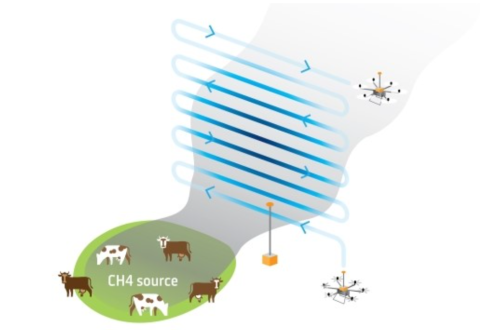New methods have been developed to help New Zealand farmers, landfill operators, and wastewater treatment facilities more accurately measure their methane emissions, verify sources and validate efforts to reduce them.
Researchers at Earth Sciences New Zealand (formerly NIWA) anticipate the innovations, which include using drone and vehicle-mounted sensors, will not only give users more precise and accurate information, but will also enable more rapid assessment of efforts to reduce methane emissions.
Methane (CH₄) is New Zealand’s most significant greenhouse gas, making up over 50% of the country’s emissions, primarily from farmed livestock and waste facilities. Unlike CO₂, methane is more potent but shorter-lived, meaning reductions can have a swift climate impact. The initiative is delivering a suite of tools to help New Zealand’s largest methane-emitting sectors, says atmospheric scientist at Earth Sciences New Zealand Dr Peter Sperlich.
“These new methods can be game changers for our agriculture sector and for the waste industry. To address the problem of how to accurately measure methane emissions from agriculture, landfills and wastewater, we’ve tested new ground-based and airborne technologies. By combining mobile technology and atmospheric science with world-first measurement techniques, we have improved our national capability for methane monitoring at the paddock and facility scale.”
In developing the new ways to measure methane, Dr Sperlich and team undertook a controlled release experiment, which revealed excellent accuracy of the new technology. From then onwards, the team worked with facility operators and farmers to trial this technique in the real world, as well as to compare the performance to that of other techniques the industry is using.
“The aim of our work has been to standardise the measurement of emissions across sectors, improve national emissions inventories, and support strategies for reducing emissions. This is about enabling New Zealand’s methane emitters to better understand current emissions and how they’re changing. With this knowledge, farm and facility operators can make targeted changes to reduce emissions and then test whether those changes actually worked. That’s a huge leap forward.”
“We’ve created a system that is both accurate and mobile,” he says. “We can measure even very small changes in methane levels, which makes it possible to test the success of mitigation strategies in real-time. This is really useful for landfill and wastewater operations because it allows you to not just measure emissions, but to do ‘before and after’ testing to evaluate if your changes are making a difference. Operators at these sites can now quantify emissions with a degree of certainty that was previously out of reach, essential for compliance, reporting, and planning mitigation.”
The researchers say these tools will ultimately support New Zealand in meeting its emissions reduction goals by giving industry the data it needs to act with confidence.
Researchers have been applying the technology in the field with a project to verify whether methane emissions on farms have come from agricultural practices or adjacent wetlands. The research offers practical insights for farmers, says greenhouse gas emission scientist Dr Christian Stiegler, also from Earth Sciences New Zealand.
“Wetlands have high ecological value but methane emissions from wetlands may be falsely attributed to agricultural activities. Our trials in the Wairarapa aim to better understand where the methane is coming from and we do that by studying methane at the molecular level. In the field, we use our mobile platforms to find methane plumes and collect air samples for isotope analysis. We use the isotopic information of methane to characterise different source categories, such as dairy cows or wetlands. With these measurements, we want to establish a marker that can be used to track down methane emissions to its original source.”

Beyond agriculture, Earth Sciences New Zealand researchers are also testing to what degree isotope techniques can pinpoint the relative contributions of different emitters within a single waste facility, to provide more granular information to the operators.
“Together we’re developing techniques that really push the boundaries of accurate measurements and correct source attribution for New Zealand’s biggest methane emitters,” says Dr Sperlich. “Our aim is to give New Zealand’s farmers and waste operators a clear view of what’s happening, and a credible way to make meaningful improvements.”

